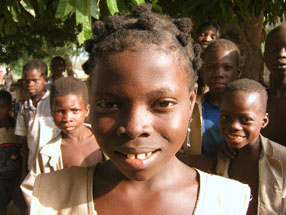
In Koutagba, Benin the customary path for young school-aged girls is to be initiated into the traditional voodoo cult and prepared for marriage. But when Nanavi Togénou was nine years old, the village voodoo priest gave her permission to go to school instead – making her the only girl in her family to attend school.
Nanavi is a participant in a nationwide effort in Benin, West Africa, called “fille-pour-fille or “girl for girl,” a program working to educate girls in Benin – a country with one of the worst literacy rates and biggest educational gender gaps in the world.
Today Nanavi is in 6th grade and defeating the odds in Benin, a country where 38 per cent of boys go to secondary school compared to 17 per cent of girls
Not only does putting girls like Nanavi in school in developing countries benefit the collective community educating women can also help dramatically curb the booming population, according to a recent article in the journal Nature.
“Secondary education increases people’s capacity and motivation to reduce their own fertility, improve the survival of their children and care for their own and the families’ health,” said Joel Cohen professor of populations at the Rockefeller University in New York.
It’s very simple: Girls who go to secondary school marry later and tend to have fewer, healthier babies.
With a global population of 6.7 billion, the United Nations projects that number will hit 9.1 billion by 2050 and that the majority of the growth will come from developing countries in Africa and South East Asia.
According to Cohen, if each woman has, on average, half a child more than estimates, then by 2050 the world population could be as high as 10.8 billion. Yet if each woman has half a child less, the global population could be as low as 7.8 billion.
“Thus a difference in fertility of a single child per woman between now and 2050 alters the 2050 estimate by three billion, a difference equal to the entire world population in 1960,” Cohen says.
Gene Sperling, director of the Center for Universal Education for the Council on Foreign Relations and former top economic adviser to President Bill Clinton, said that this is a silent crisis engulfing developing countries.
“You know, you never see a child die from education on TV. But make no mistake about it. Children die from lack of education all the time. Children are more likely to grow up to have HIV/AIDS. They’re more likely to die in infancy or before the age of five, dependent on their education and particularly the education of their mothers. So this is a life or death issue,” said Sperling, author of “What Works in Girls’ Education,” (with Barbara Herz).
Benin’s First Lady, Chantal de Souza Yayi, recently launched the country’s fourth All Girls to School campaign, aiming to raise awareness among community leaders, parents, traditional chiefs, the media and children themselves about the critical importance of sending all children, specifically girls, to school.
